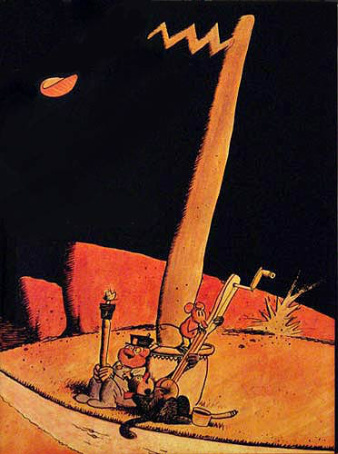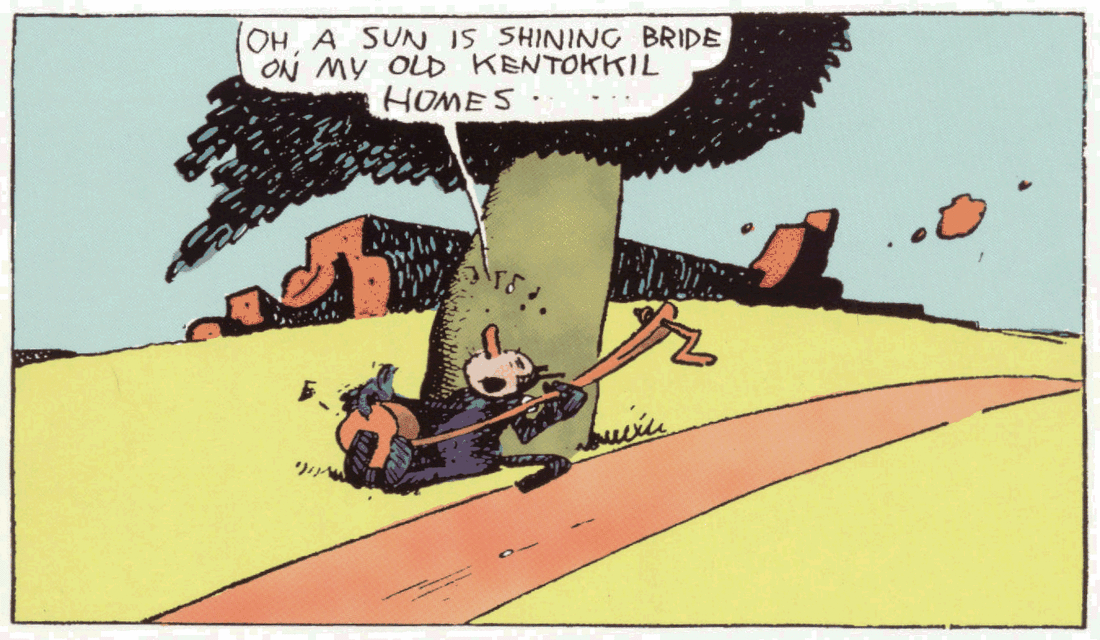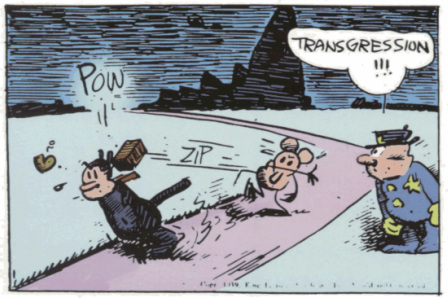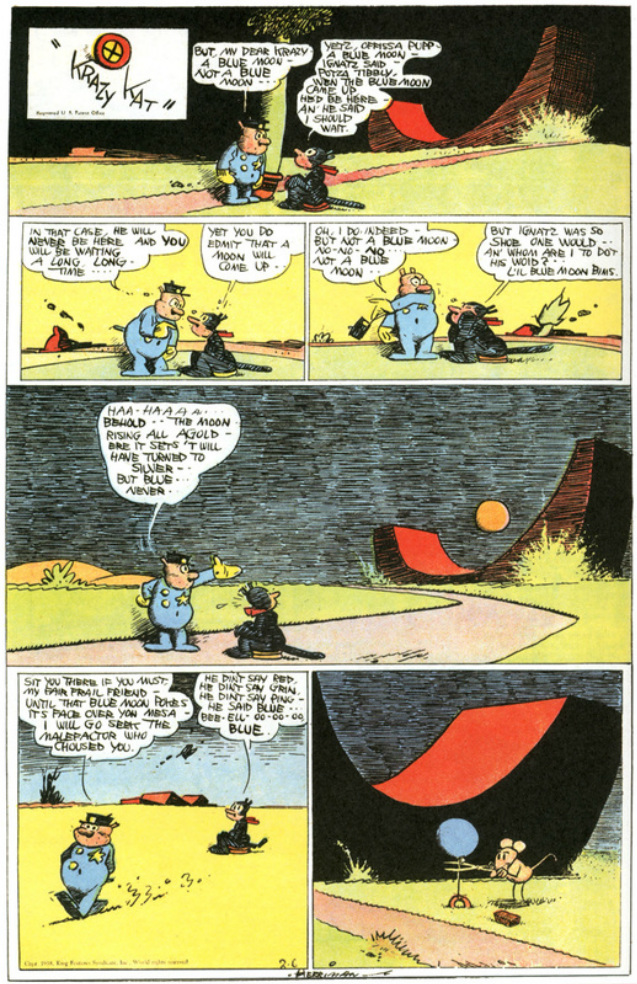For the love of Krazy Kat by Mark Magula
It may be that the best and earliest example of visual humor comes not from the slapstick comedians of the 1920’s or 30’s, like Chaplin, the Marx Bros. or W.C. Fields, but from artists, that drew the funny pages. The Sunday funnies first appeared in the late 19th century before film and about the same time as vaudeville. The visual medium of comics allowed humorists to set up stunts and situations that no human could ever perform with its own internal logic, fulfilling only one necessary demand, that if you could draw funny, it was funny.
One of the most successful was by a man named George Herriman; George Joseph Herriman was born in New Orleans August 22, 1880. By the time he was fifteen he was already selling cartoons that were syndicated around the U.S. His work was a unique blend of cutting edge slapstick that was informed by a kind of metaphysical silliness that did what all great humor and art should do, it defied people’s expectations and offered a peculiar vision of the world as only Herriman saw it.
One of the most successful was by a man named George Herriman; George Joseph Herriman was born in New Orleans August 22, 1880. By the time he was fifteen he was already selling cartoons that were syndicated around the U.S. His work was a unique blend of cutting edge slapstick that was informed by a kind of metaphysical silliness that did what all great humor and art should do, it defied people’s expectations and offered a peculiar vision of the world as only Herriman saw it.

Krazy Kat and his/her friends lived in a surreal version of Coconino County Arizona, one that reflected the cultural influence of the pueblo Indians on Herriman's art. He devised a kind of homemade patois that was the language of his creation Yiddish, Spanish and slang that solidified his vision of world.
Krazy was in love with Ignatz, a scrawny mouse, who couldn't tolerate Krazy’s advances. This inevitably led to Ignazt responding to Krazy with a brick to the head. It never got much more complex than that. It was Herriman’s gifts as an artist/storyteller that provided the rich visual world that his characters inhabited. With little more than a single frame and word he could create a subtext as compelling as the best fine-art or film.
Krazy Kat was one of the first comics to be widely praised by intellectuals and treated as "serious" art. Art critic Gilbert Seldes wrote a lengthy public speech about the strip in 1924, calling it "the most amusing, fantastic and satisfactory work of art produced in America today. Poet E.E. Cummings, another Herriman admirer, wrote the introduction to the first collection of the strip in book form. Other admirers included Pablo Picasso and Gertrude Stein.
Krazy was in love with Ignatz, a scrawny mouse, who couldn't tolerate Krazy’s advances. This inevitably led to Ignazt responding to Krazy with a brick to the head. It never got much more complex than that. It was Herriman’s gifts as an artist/storyteller that provided the rich visual world that his characters inhabited. With little more than a single frame and word he could create a subtext as compelling as the best fine-art or film.
Krazy Kat was one of the first comics to be widely praised by intellectuals and treated as "serious" art. Art critic Gilbert Seldes wrote a lengthy public speech about the strip in 1924, calling it "the most amusing, fantastic and satisfactory work of art produced in America today. Poet E.E. Cummings, another Herriman admirer, wrote the introduction to the first collection of the strip in book form. Other admirers included Pablo Picasso and Gertrude Stein.
Krazy Kat existed in many different incarnations, comic-strip and film as early as 1916, through the 1960’s and beyond. But, nothing is as compelling as Herriman’s original work on the funny pages. Even today his creation survives as an inspiration to illustrators. Early jazz pioneer and innovator Bix Beiderbecke payed homage to Krazy in music. In 1995 Krazy, Ignatz and George Herriman were finally honored by the U.S. government with their own stamp.
It can be difficult to think of something as common as the funny pages as art with a capital A. Some may try to infuse Krazy and his companions with a modern political or social aesthetic, that would be unfortunate. Art, when it really is art, can either comment powerfully on its time or, as in the case of Herriman's best work, transcend it.
While Krazy Kat was never more than modestly successful with American audiences, it has become a landmark for illustrators and art lovers the world over. It was voted by the Comics Journal the best cartoon/comic book of the 20th century and continues to live on in work of some of the finest cartoonist of the last hundred years.
It can be difficult to think of something as common as the funny pages as art with a capital A. Some may try to infuse Krazy and his companions with a modern political or social aesthetic, that would be unfortunate. Art, when it really is art, can either comment powerfully on its time or, as in the case of Herriman's best work, transcend it.
While Krazy Kat was never more than modestly successful with American audiences, it has become a landmark for illustrators and art lovers the world over. It was voted by the Comics Journal the best cartoon/comic book of the 20th century and continues to live on in work of some of the finest cartoonist of the last hundred years.


